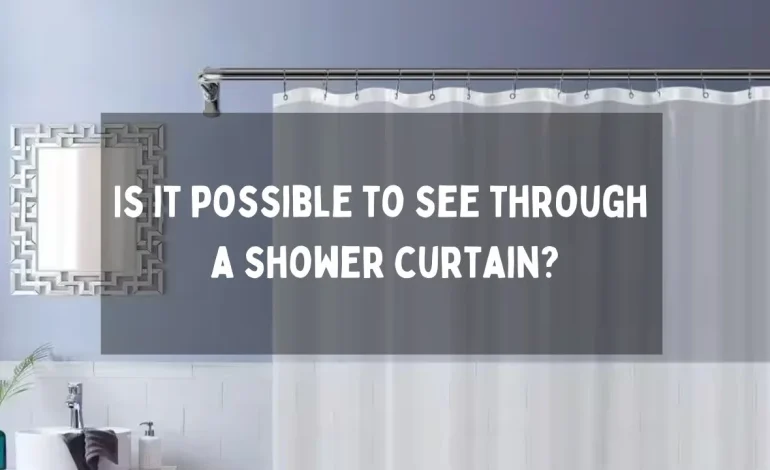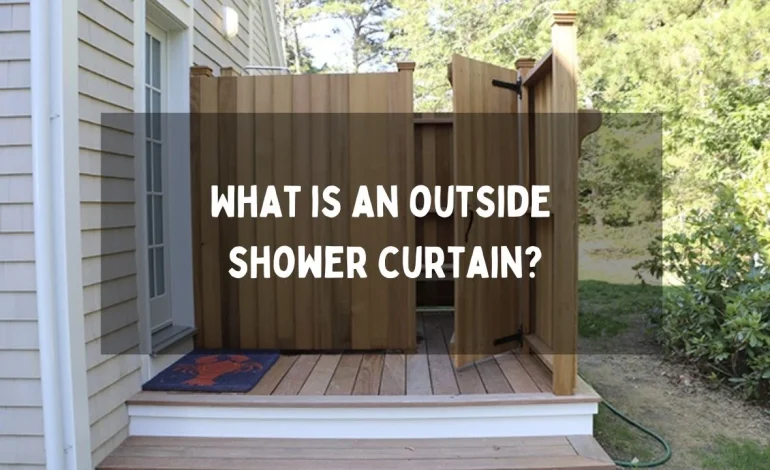
Is It Possible To See Through A Shower Curtain?
In the everyday rituals of self-care, one often encounters the enigmatic quality of a shower curtain the translucent barrier that stands between privacy and visibility in the bathroom.
The question of whether it’s possible to see through a shower curtain might seem straightforward at first glance, yet it opens the door to a fascinating realm of considerations and nuances.
From the materials used to the impact of water, from the quest for both privacy and a clear view to the evolving innovations in curtain technology, exploring the transparency of shower curtains reveals an array of factors that go far beyond mere visibility.
Can You See Through a Shower Curtain?
Transparency of different types of shower curtains:
Shower curtains come in various materials, each offering different levels of transparency.
The most common materials include vinyl, polyester, nylon, and fabric blends.
- Vinyl curtains, especially the thinner ones, tend to offer more transparency compared to thicker, opaque options.
- Fabric curtains, such as those made of cotton or linen, might be more opaque, offering less visibility.
- Some curtains also come with clear sections or are entirely transparent, often made from clear vinyl or plastic.
These varieties differ in their ability to allow light and visibility through them, impacting the overall transparency of the curtain.
Also Read: What Is An Outside Shower Curtain?
Factors influencing visibility through a shower curtain:
Several factors play a role in determining how clearly one can see through a shower curtain. The thickness and quality of the material significantly impact transparency.
Thinner materials or those specifically designed to be transparent offer clearer visibility compared to thicker, more opaque options.
The presence of patterns or designs on the curtain may also affect visibility, as intricate patterns can obscure what’s behind them.
Lighting in the bathroom is another significant factor: a well-lit bathroom might make it easier to see through the curtain, while a dimly lit space could reduce visibility.
Also Read: What Are The Benefits Of Using A Shower Curtain Liner?
Clear vs. opaque shower curtains:
The choice between clear and opaque shower curtains often boils down to personal preference and the desired level of privacy.
Clear shower curtains, usually made of transparent vinyl or plastic, offer maximum visibility. They’re popular in smaller bathrooms or spaces where ample light is available, as they can create an illusion of more space.
However, they might compromise privacy. Opaque curtains, on the other hand, provide better privacy but may limit visibility.
These curtains are available in various colors, patterns, and thicknesses, offering a range of choices to balance privacy needs with personal style preferences.
While they might limit the view, they can also serve as a design element in the bathroom, adding aesthetic value.
Also Read: Why Is A Shower Curtain Important For Shower Enclosures?
Pros and Cons of Various Materials Regarding Transparency:
Vinyl:
- Pros: Thin vinyl curtains offer good transparency, allowing light to pass through and making visibility easier. They are generally affordable and easy to clean.
- Cons: Lower-quality vinyl might become cloudy or discolored over time, reducing transparency. Thicker vinyl curtains can be less transparent and might feel less visually appealing.
Polyester:
- Pros: Polyester curtains are available in various thicknesses, offering options for transparency. They are often durable and can maintain their transparency well over time.
- Cons: Thicker polyester curtains might limit visibility and natural light, while very thin ones might sacrifice durability.
Nylon:
- Pros: Nylon curtains can offer good transparency, especially in thinner varieties. They are often more lightweight and can be quick-drying.
- Cons: Similar to other materials, thicker nylon curtains might reduce transparency, and they might not be as resistant to mold or mildew.
Fabric Blends:
- Pros: Fabric curtains made from blends like cotton or linen can provide a range of design options. Thinner fabric blends might offer better visibility.
- Cons: Thicker fabric blends can significantly reduce transparency and might require a liner for better water resistance, which can further obstruct visibility.
Clear Plastic or Vinyl:
- Pros: These transparent curtains offer maximum visibility, allowing light to pass through easily, which can create an illusion of space in smaller bathrooms.
- Cons: Lack of privacy might be a concern, and they might require frequent cleaning to maintain their transparency. Cheaper versions might become cloudy over time.
Also Read: Home with Keki Interior Design Blogger
Does Water Affect Transparency?
Yes, water can significantly affect the transparency of a shower curtain in several ways, especially during and after showering. Understanding how water impacts the transparency of the curtain is essential for maintaining visibility and managing potential issues.
Here are the primary ways in which water affects the transparency of a shower curtain:
- Condensation and Steam:
- Water Droplets:
- Mold and Mildew:
- Material Absorption:
Some materials, particularly fabric-based curtains, may absorb water, temporarily reducing transparency until they dry.
To mitigate these effects, proactive measures such as wiping down the curtain post-shower, ensuring adequate ventilation to reduce moisture, and choosing materials less prone to water absorption can help maintain better visibility through the curtain.
Regular cleaning and maintenance are crucial for preserving transparency and extending the curtain’s lifespan.
Also Read: Dream House Modern Duplex House Designs In Nigeria
How water and steam affect visibility through the curtain?
Water and steam in the bathroom can significantly affect the visibility through a shower curtain. Here’s how they impact visibility:
Condensation and Steam:
When hot water is running during a shower, steam is generated, causing condensation on the inside of the curtain. This condensation creates a foggy effect on the curtain, reducing its transparency.
As a result, visibility through the curtain from the outside is diminished. The thicker the condensation, the harder it becomes to see through the curtain.
Obstruction due to Water Droplets:
Water droplets generated by the shower can cling to the surface of the curtain.
Even after the shower is finished, these droplets might dry on the curtain, leaving behind residue or watermarks that obstruct the view.
This effect is particularly noticeable on clear or transparent curtains where the accumulation of droplets can significantly reduce visibility.
Impact on Material and Design:
Materials like vinyl or plastic, when exposed to consistent moisture, might become cloudy or less transparent over time.
Additionally, intricate designs or patterns on the curtain might become more pronounced when exposed to water, further obstructing visibility through the curtain.
Also Read: House Plans With Game Room
How to choose a shower curtain based on visibility preferences?
Choosing a shower curtain based on visibility preferences involves considering several factors to balance transparency, style, and functionality. Here are steps to guide your selection process:
Material Selection:
Opt for materials that align with your visibility preferences. If transparency is a priority, consider thinner vinyl or clear plastic curtains.
For a balance between visibility and privacy, look for translucent materials that offer some visibility but maintain a level of opaqueness.
Thicker or opaque materials, such as fabric blends, offer more privacy but might limit visibility.
Transparency Level:
Clear or transparent curtains provide maximum visibility but compromise on privacy. If you value visibility and have a well-lit bathroom, a clear curtain might be suitable.
Semi-transparent or frosted curtains strike a balance between visibility and privacy, allowing light in while obstructing a clear view.
Pattern and Design:
Intricate designs or patterns on a curtain might impact visibility. Solid-colored curtains or those with simple patterns might offer better transparency compared to heavily printed ones.
Consider the impact of the design on your visibility preferences when making your choice.
Curtain Length and Size:
The length and size of the curtain also affect visibility. If you have a smaller bathroom, a longer or wider curtain might make the space feel more enclosed.
Consider a curtain that matches the size of your shower or bathtub area without overwhelming the space.
Lighting in the Bathroom:
Adequate lighting can significantly impact visibility through the curtain. If your bathroom is well-lit, it might enhance the transparency of the curtain, allowing for better visibility.
Maintenance and Longevity:
Choose a curtain material that retains its transparency over time. Some materials, like certain types of vinyl or plastic, might become cloudy or discolored with extended use. Consider materials that are easy to clean and maintain for long-term visibility.
Accessories and Liners:
Consider using liners or accessories like sheer panels or secondary curtains if you prefer a certain design or material that compromises visibility. These additions can provide privacy while still allowing natural light to filter through.
Also Read: What Are The Best House Plan For A Plot Of Size 20 *50 Feet?
Safety considerations when selecting transparent shower curtains
When selecting transparent shower curtains, safety considerations are crucial to ensure a comfortable and secure bathroom environment. Here are key safety factors to consider:
- Ensure the curtain material is of high quality and free from harmful substances. Low-quality plastics or vinyl may emit volatile organic compounds (VOCs), leading to potential health risks. Look for materials that are PVC-free or explicitly labeled as non-toxic to prevent off-gassing.
- Transparent curtains should be thick enough to withstand regular use without tearing or ripping easily. Thicker materials provide better durability and reduce the risk of accidental tears or breakage.
- Transparent curtains, especially in humid environments, are susceptible to mold and mildew growth. Look for materials with antimicrobial properties or those specifically designed to resist mold and mildew to maintain a hygienic and safe environment.
- Some individuals might have sensitivities or allergies to certain chemicals found in plastics or vinyl. Ensure the chosen material is hypoallergenic or labeled as safe for individuals with chemical sensitivities.
- Opt for curtains that have some level of slip resistance. Water on the bathroom floor might make it slippery, so selecting a curtain that doesn’t encourage pooling of water on the floor is important for safety.
- Consider curtains with clear markings or indicators to avoid accidental collisions or mishaps. Some curtains feature hemlines or patterns at eye level to help users gauge the edge and prevent accidents.
- Though less common in shower curtains, fire retardant materials are important for safety in case of emergencies. Check if the curtain material has fire-resistant properties for added safety.
- Follow manufacturer guidelines for proper installation to prevent accidents related to improper mounting.
- Regularly clean and maintain the curtain to prevent the buildup of soap scum or other substances that might reduce visibility and pose safety hazards.
Also Read: What Order Does Width, Length, Or Height Go In?
Conclusion:
The selection of a shower curtain based on visibility preferences involves a thoughtful balance between transparency, privacy, material, design, and safety.
Understanding the impact of water, steam, and material quality is crucial in making an informed choice.
Whether opting for a clear, translucent, or opaque curtain, it’s essential to consider the environment, lighting, and maintenance required to preserve visibility.
Safety considerations, such as material quality, resistance to mold, slip resistance, and fire retardant properties, ensure a secure bathroom setting.
FAQs
Do clear shower curtains compromise privacy?
Clear shower curtains offer high visibility but compromise privacy. They are suitable for well-lit bathrooms or in spaces where privacy isn’t a primary concern.
Can I improve visibility through a shower curtain?
Regular maintenance, choosing the right material, and managing water droplets can enhance visibility through the curtain. Additionally, using clear or translucent curtains instead of opaque ones can improve visibility.
What materials are best for a transparent shower curtain?
Vinyl, clear plastic, or certain polyester materials can provide better transparency. Look for those that are durable and resistant to clouding or discoloration over time.
How can I prevent mold or mildew on a transparent shower curtain?
Opt for curtains with antimicrobial properties or those specifically designed to resist mold and mildew. Regular cleaning and ensuring proper ventilation can also prevent their growth.
Are transparent shower curtains safe for individuals with chemical sensitivities?
Some individuals might have sensitivities to certain materials. Look for curtains labeled as hypoallergenic or non-toxic to minimize potential health risks.
Do transparent curtains tend to be slippery?
Some may be slippery due to water accumulation. Look for curtains that offer slip-resistant properties or consider using a bath mat to prevent slipping accidents.





